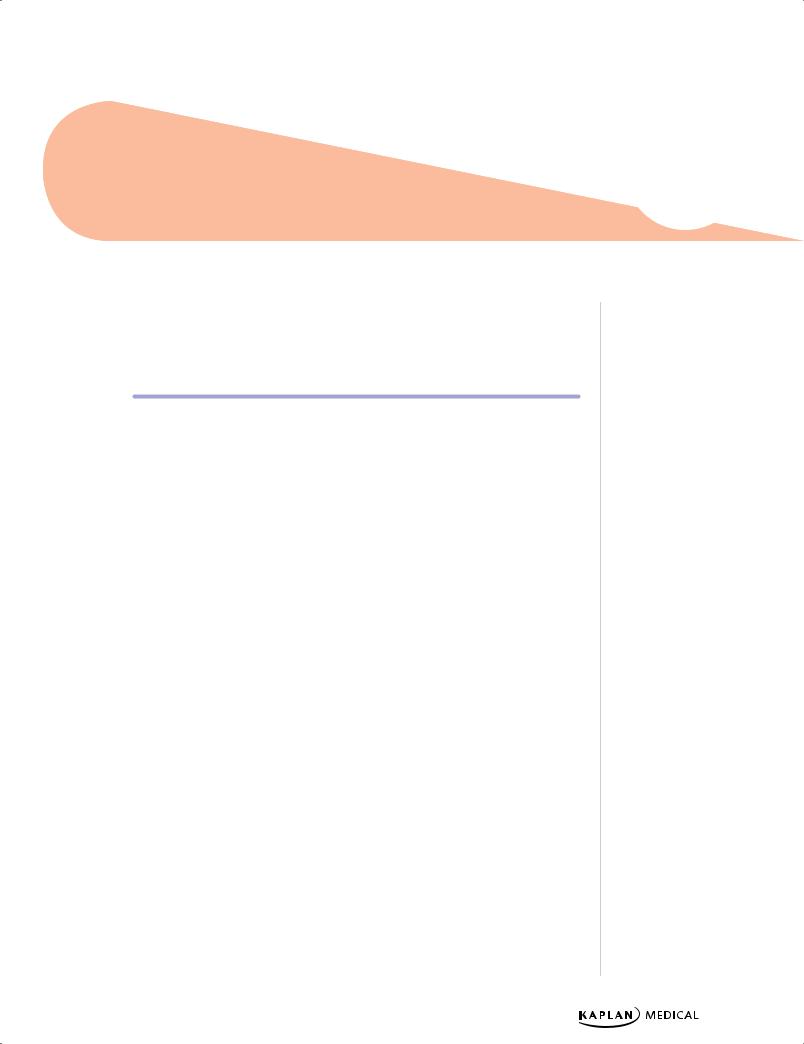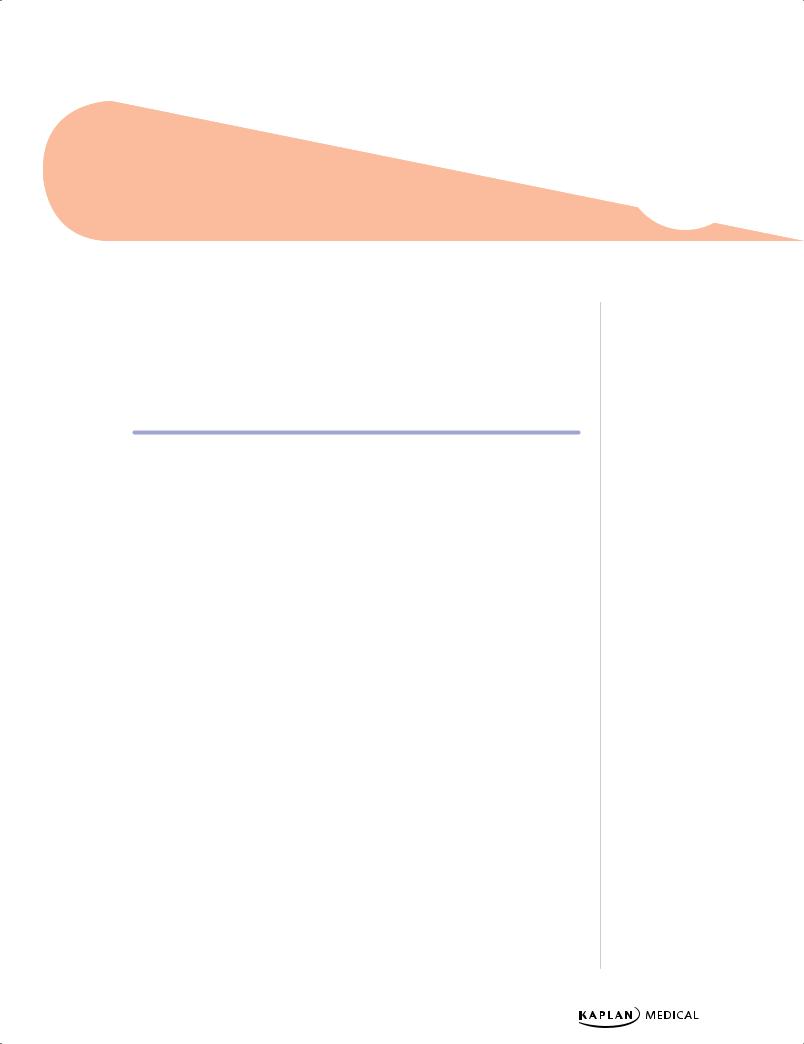
Полезные материалы за все 6 курсов / Учебники, методички, pdf / Kaplan Pediatrics USMLE 2CK 2021
.pdf

Disorders of the |
12 |
Ear, Nose,Chapterand ThroatTitle |
Learning Objectives
Describe diagnosis and treatment of disorders of the ears, nose, and throat in childhood
Demonstrate understanding of disorders of the oral cavity
EARS
External Ear
Otitis externa (swimmer’s ear)
•Normal flora of external canal includes Pseudomonas aeruginosa (most common cause), S. aureus (second most common cause), coagulase-negative Staphylococcus, diphtheroids, Micrococcus spp., and viridans streptococci
•Causes—excessive wetness, dryness, skin pathology, or trauma
•Symptoms—significant pain (especially with manipulation of outer ear), conductive hearing loss
•Findings—edema, erythema, thick otorrhea, preauricular nodes
•Malignant external otitis is invasive to temporal bone and skull base, with facial
paralysis, vertigo, other cranial nerve abnormalities; requires immediate culture, IV antibiotics, and imaging (CT scan) → may need surgery
•Treatment—topical otic preparations ± corticosteroids
•Prevention—earplugs, thorough drying of canal, and 2% acetic acid after getting wet
Middle Ear
Otitis media (OM)
A 4-year-old child is seen in the office with a 3-day history of fever and cold symptoms and now complains of right ear pain. Physical examination is remarkable for a bulging tympanic membrane with loss of light reflex and landmarks.
•Acute, suppurative otitis media; accompanied by a variable degree of hearing loss (20–30 dB)
Published by dr-notes.com |
105 |
|
|
|
|

USMLE Step 2 CK λ Pediatrics
Clinical Correlate
Otitis Media
Correlated Factors
•Commonly first 2 yrs of life; boys > girls; Native Americans/Inuit; low SES
•Heritable genetic component
•Protective effect of breast milk vs. formula
•Positive correlation to both tobacco smoke and exposure to other children
•Season: cold weather
•Congenital anomalies: more with palatal clefts, other craniofacial anomalies, and Down syndrome
Note
Abnormal Exam Findings
Purulent otorrhea: sign of otitis externa, otitis media with perforation and/or drainage from middle ear through tympanostomy tube
Bulging TM: increased middle ear pressure with pus or effusion in middle ear
TM retraction: negative middle ear pressure (more rapid diffusion of air from middle ear cavity than its replacement via the eustachian tube)
Other findings for an effusion: bubbles, air-fluid level seen behind TM
•Etiology
–Bacterial (up to 75%): S. pneumoniae (40%); nontypeable H. influenzae (25–30%);
Moraxella catarrhalis (10–15%)
–Other 5%: Group A strep, S. aureus, gram negatives (neonates and hospitalized very young infants), respiratory viruses (rhinovirus, RSV most often)
•Pathogenesis
–Interruption of normal eustachian tube function (ventilation) by obstruction → inflammatory response → middle ear effusion → infection; most with URI
–Shorter and more horizontal orientation of tube in infants and young children allows for reflux from pharynx (and in certain ethnic groups and syndromes)
•Clinical findings highly variable
–Symptoms: ear pain, fever, purulent otorrhea (ruptured tympanic membrane), irritability, or no symptoms
–Pneumatic otoscopy: fullness/bulging or extreme retraction, intense erythema (otherwise erythema may be from crying, fever, sneezing; erythema alone is insufficient unless intense), some degree of opacity (underlying effusion)
–Mobility is the most sensitive and specific factor to determine presence of a middle ear effusion (pneumatic otoscopy)
•Diagnosis: must have acute onset, tympanic membrane inflammation, middle ear effusion
•Treatment: advisable to use routine antimicrobial treatment especially for age
<2 years or those systemically ill, with severe infection, or with history of recurrent acute otitis media.
–Pain relief is essential: acetaminophen, NSAIDs (except acetylsalicylic acid because of risk of Reye syndrome)
–First-line drug of choice = amoxicillin (high dose)
–Alternate first-line drug or history of penicillin allergy = azithromycin
–In some patients age >2 years with no high fever or severe pain, observation and reevaluation in 2-3 days are acceptable; if no improvement, start antibiotics.
–Duration: 10 days; shorter if mild, older child
–Follow up: within days for young infants, continued pain or severe; otherwise 8–12 wks if age <2 yrs or ≥2 yrs and with language/learning problems (sustained improvement seen in TM)
–Second-line drugs—if continued pain after 2–3 days
°Amoxicillin-clavulanic acid (effective against β-lactamase producing strains)
°Cefuroxime axetil (unpalatable, low acceptance)
°IM ceftriaxone (may need repeat 1–2×; for severe infection if oral not possible) if patient is not taking/tolerating oral medications
°Also maybe cefdinir (very palatable, shorter duration)
°If clinical response to good second-line drug is unsatisfactory, perform myringotomy or tympanocentesis
Otitis media with effusion (OME)
•Generally after repeated infections with insufficient time for effusion to resolve
•Fullness is absent or slight or TM retracted; no or very little erythema
106

Chapter 12 λ Disorders of the Ear, Nose, and Throat
•Treatment
–Monthly evaluation
–Assess hearing if effusion >3 months; most resolve without problems
–Recent studies suggest that in otherwise healthy children an effusion up to
9 months in both ears during first 3 years of life poses no developmental risks at 3–4 years of life.
–Routine antibiotic prophylaxis is not recommended.
–Tympanostomy tubes
°For children with bilateral OME and impaired hearing for >3 months; prolonged unilateral or bilateral OME with symptoms (school or behavioral problems, vestibular, ear discomfort); or prolonged OME in cases of risk for developmental difficulties (Down syndrome, craniofacial disorders, developmental disorders).
°Likelihood that middle ear ventilation will be sustained for at least as long as tubes remain in (average 12 months)
•Complications
–Acute mastoiditis: displacement of pinna inferiorly and anteriorly and inflammation of posterior auricular area; pain on percussion of mastoid process
°Diagnosis: when suspected or diagnosed clinically, perform CT of temporal bone
°Treatment: myringotomy and IV antibiotics (S. pneumoniae, nontypeable
H. influenzae, P. aeruginosa); if bone destruction, intravenous antibiotics and mastoidectomy
–Acquired cholesteatoma = cyst-like growth within middle ear or temporal bone; lined by keratinized, stratified squamous epithelium
°Most with long-standing chronic otitis media
°Progressively expands: bony resorption and intracranially; life-threatening
°Discrete, white opacity of eardrum through a defect in TM or persistent malodorous ear discharge
°CT scan to define presence and extent
°Treatment: tympanomastoid surgery
Clinical Recall
A 5-year-old boy with a history of recurrent acute otitis media and penicillin allergy receives a diagnosis of otitis media with effusion. What is the next step?
A.Prescribe amoxicillin
B.No antibiotics are needed
C.Refer for tympanostomy tube placement
D.Prescribe azithromycin
E.Admit for IV antibiotics
Answer: D
Published by dr-notes.com |
107 |
|
|
|
|

USMLE Step 2 CK λ Pediatrics
ORAL CAVITY
Cleft Lip and Palate
•Most are multifactorial inheritance; also autosomal dominant in families (most with isolated cleft palate)
•Clefts are highest among Asians, lowest among African descent
•Increase in other malformations with isolated cleft palate
•Most important early issue is feeding (special nipple needed)
•Complications—increased risk of otitis media, hearing loss, speech problems
•Treatment—surgical correction
−Lip at 3 months of age
−Palate at <1 year
NOSE AND THROAT
Nose
Choanal atresia
A newborn is noted to be cyanotic in the wellborn nursery. On stimulation, he cries and becomes pink again. The nurse has difficulty passing a catheter through the nose.
•Unilateral or bilateral bony (most) or membranous septum between nose and pharynx
–Half have other anomalies (CHARGE association)
–Unilateral—asymptomatic for long time until first URI, then persistent nasal discharge with obstruction
–Bilateral—typical pattern of cyanosis while trying to breathe through nose, then becoming pink with crying; if can breathe through mouth, will have problems while feeding
•Diagnosis
–Inability to pass catheter 3−4 cm into nasopharynx
–Fiberoptic rhinoscopy
–Best way to delineate anatomy is CT scan
•Treatment
–Establish oral airway, possible intubation
–Transnasal repair with stent(s)
Foreign body
•Any small object
•Clinical—unilateral purulent, malodorous bloody discharge
•Diagnosis—may be seen with nasal speculum or otoscope; lateral skull film if radiopaque (may have been pushed back, embedded in granulation tissue)
•Treatment—if cannot easily remove with needle-nose forceps, refer to ENT
108

Chapter 12 λ Disorders of the Ear, Nose, and Throat
Epistaxis
An 8-year-old child has repeated episodes of nosebleeds. Past history, family history, and physical examination are unremarkable.
•Common in childhood; decreases with puberty
•Most common area—anterior septum (Kiesselbach plexus), prone to exposure
•Etiology
–Digital trauma (nose picking; most common)
–Dry air (especially winter)
–Allergy
–Inflammation (especially with URI)
–Nasal steroid sprays
–Severe GERD in young infants
–Congenital vascular anomalies
–Clotting disorders, hypertension
•Treatment—most stop spontaneously
–Compress nares, upright, head forward; cold compress
–If this does not work, then local oxymetazoline or phenylephrine
–If this does not work, then anterior nasal packing; if it appears to be coming posteriorly, need posterior nasal packing
–If bleeding site identified, cautery
–Use humidifier, saline drops, petrolatum for prevention
Polyps
•Benign pedunculated tumors from chronically inflamed nasal mucosa
– Usually from ethmoid sinus external to middle meatus
•Most common cause is cystic fibrosis—suspect in any child <12 years old with polyp; EVEN in absence of other typical symptoms
•May also be associated with the Samter triad (polyps, aspirin sensitivity, asthma)
•Presents with obstruction → hyponasal speech and mouth breathing; may have profuse mucopurulent rhinorrhea
•Examination—generally glistening, gray, grape-like masses
•Treatment—intranasal steroids/systemic steroids may provide some shrinkage (helpful in CF); remove surgically if complete obstruction, uncontrolled rhinorrhea, or nose deformity.
Sinusitis
•Acute—viral versus bacterial
•Most with URI—most viral, self-limited; up to 2% complicated by bacterial sinusitis
•Sinus development
–Ethmoid and maxillary present at birth, but only ethmoid is pneumatized
–Sphenoid present by 5 years
–Frontal begins at 7–8 years and not completely developed until adolescence
Published by dr-notes.com |
109 |
|
|
|
|

USMLE Step 2 CK λ Pediatrics
Note
The same organisms that are responsible for AOM are also implicated in sinusitis.
110
•Etiology—S. pneumonia, nontypeable H. influenzae, M. catarrhalis; S. aureus in chronic cases
–May occur at any age
–Predisposed with URI, allergy, cigarette smoke exposure
–Chronic—immune deficiency, CF, ciliary dysfunction, abnormality of phagocytic function, GERD, cleft palate, nasal polyps, nasal foreign body
•Pathophysiology—fluid in sinuses during most URIs from nose blowing. Inflammation and edema may block sinus drainage and impair clearance of bacteria.
•Clinical features
–Nonspecific complaints—nasal congestion, discharge, fever, cough
–Less commonly—bad breath, decreased sense of smell, periorbital edema headache, face pain
–Sinus tenderness only in adolescents and adults; exam mostly shows mild erythema and swelling of nasal mucosa and discharge
•Diagnosis—entirely historical and clinical presentation (evidence-based)
–Persistent URI symptoms without improvement for at least 10 days
–Severe respiratory symptoms with purulent discharge and temperature at least 38.9 C (102 F) for at least 3 consecutive days
°Only accurate method to distinguish viral versus bacterial is sinus aspirate and culture, but this is NOT done routinely
°Sinus films/CT scans—show mucosal thickening, opacification, air-fluid levels but does not distinguish viral versus bacterial
•Treatment
–Initial—amoxicillin (adequate for majority)
–Alternative—cefuroxime axetil, cefpodoxime, azithromycin
–Treat 7 days past improvement
–If still does not work—to ENT (maxillary sinus aspirate)
Throat
Acute pharyngitis
An 8-year-old girl complains of acute sore throat of 2 days’ duration, accompanied by fever and mild abdominal pain. Physical examination reveals enlarged, erythematous tonsils with exudate and enlarged, slightly tender cervical lymph nodes.
•Viruses versus group A beta-hemolytic strep (GABHS)
•Viral—typical winter and spring; close contact
•GABHS—uncommon <2–3 years of age; increased incidence in childhood, then decreases in adolescence; all year long (but most in cold months)
•Clinical presentation
–Strep pharyngitis
°Rapid onset
°Severe sore throat and fever

Chapter 12 λ Disorders of the Ear, Nose, and Throat
°Headache and gastrointestinal symptoms frequently
°Exam—red pharynx, tonsillar enlargement with yellow, blood-tinged exudate, petechiae on palate and posterior pharynx, strawberry tongue, red swollen uvula, increased and tender anterior cervical nodes
–Scarlet fever—from GABHS that produce one of 3 streptococcal pyogenic exotoxins (SPE A, B, C); exposure to each confers a specific immunity to that toxin, so a person can have scarlet fever up to 3 times
°Findings of pharyngitis plus circumoral pallor
°Red, finely papular erythematous rash diffusely that feels like sandpaper
°Pastia lines in intertriginous areas
–Viral—more gradual; with typical URI symptoms; erythematous pharynx, no pus
°Pharyngoconjunctival fever (adenovirus)
°Coxsackie:
Herpangina—small 1–2 mm vesicles and ulcers on posterior pharynx
Acute lymphonodular pharyngitis—small 3–6 mm yellowish-white nodules on posterior pharynx with lymphadenopathy
Hand-foot-mouth disease—inflamed oropharynx with scattered
vesicles on tongue, buccal mucosa, gingiva, lips, and posterior pharynx → ulcerate; also on hands and feet and buttocks; tend to be painful
•Diagnosis of strep
–First—rapid strep test; if positive, do not need throat culture
°But must confirm a negative rapid test with cultures if clinical suspicion is high
•Treatment—early treatment only hastens recovery by 12–24 hours but prevents acute rheumatic fever if treated within 9 days of illness
–Penicillin
–Allergy—erythromycin
•Complications
–Retropharyngeal and lateral pharyngeal abscess—deep nodes in neck; infection from extension of localized infection of oropharynx
°Clinical—nonspecific—fever, irritability, decreased oral intake, neck stiffness, torticollis, refusal to move neck, muffled voice
°Examination—bulging of posterior or lateral pharyngeal wall
°Soft tissue neck film with head extended may show increase width
°Definitive diagnosis—incision and drainage, C and S—most polymicrobial
(GABHS, anaerobes, S. aureus)
°Treatment
Intravenous antibiotics + surgical drainage
Third-generation cephalosporin plus ampicillin/sulbactam or clindamycin
Surgical drainage needed if respiratory distress or failure to improve
–Peritonsillar abscess—bacterial invasion through capsule of tonsil
°Typical presentation—adolescent with recurrent history of acute pharyngotonsillitis
°Sore throat, fever, dysphagia, trismus
Note
Causes of Cervical
Lymphadenitis
•Infections
–Viral/bacterial pharyngitis
–Cat scratch disease
–Tb/atypical mycobacteria
–Mumps
–Thyroglossal duct cyst
–Branchial cleft cyst
•Cystic hygroma
•Tumors (rare)
Published by dr-notes.com |
111 |
|
|
|
|

USMLE Step 2 CK λ Pediatrics
°Examination—asymmetric tonsillar bulge with displacement of uvula away from the affected side is diagnostic
°GABHS + mixed oropharyngeal anaerobes
°Treatment
Antibiotics and needle aspiration
Incision and drainage
Tonsillectomy if recurrence or complications (rupture with aspiration)
Clinical Recall
A 7-year-old girl presents with fever and sore throat. Exam reveals tonsillar erythema and exudates. Rapid strep test is positive. What is the next step?
A.Swab the throat for culture
B.Prescribe penicillin
C.Obtain a blood culture
D.Advise rest and fluids with follow-up as needed
E.Perform a second rapid strep test for confirmation
Answer: B
112

Cardiology 13
Chapter Title
Learning Objectives
Demonstrate understanding of the pediatric cardiac evaluation
Categorize disorders in which left-to-right shunt, right-to-left shunt, or hypertension occurs
Recognize stenotic, regurgitant, and mixed disorders
CARDIAC EVALUATION AND CONGENITAL HEART LESIONS
Children do not present with the typical features of congestive heart failure as seen in adults. Age is very important when assessing the child.
•Infants:
−Feeding difficulties
−Easily fatigued
−Sweating while feeding
−Rapid respirations
•Older children:
−Shortness of breath
−Dyspnea on exertion
•Physical examination
−Need to refer to normal heart and respiratory rates for ages to determine tachycardia and tachypnea.
−Height and weight should be assessed to determine proper growth.
−Always get upper and lower extremity blood pressures and pulses.
−Hepatosplenomegaly suggests right-sided heart failure.
−Rales on auscultation may indicate pulmonary edema and left-sided heart failure.
−Cyanosis and clubbing result from hypoxia.
Note
Orthopnea and nocturnal dyspnea are rare findings in children.
Published by dr-notes.com |
113 |
|
|
|
|
